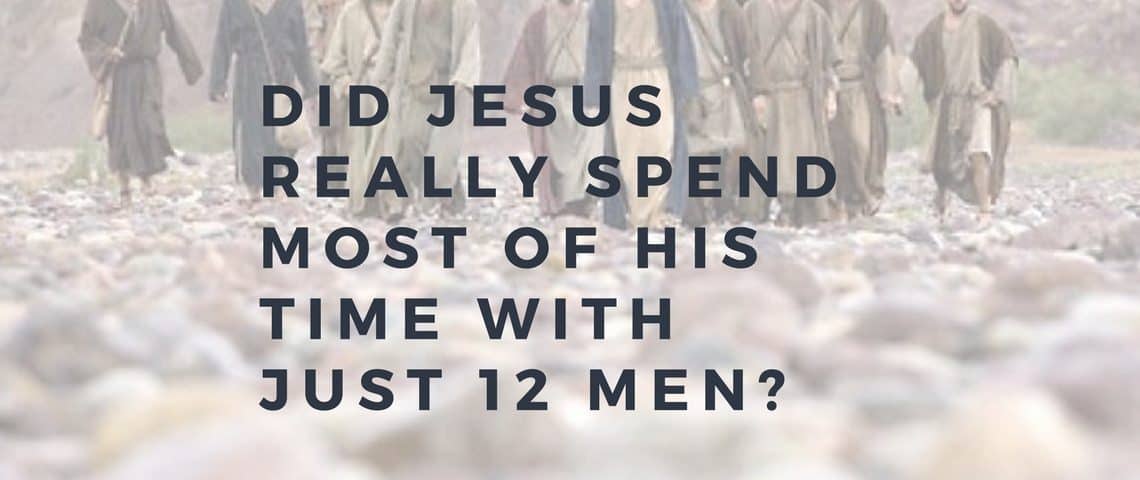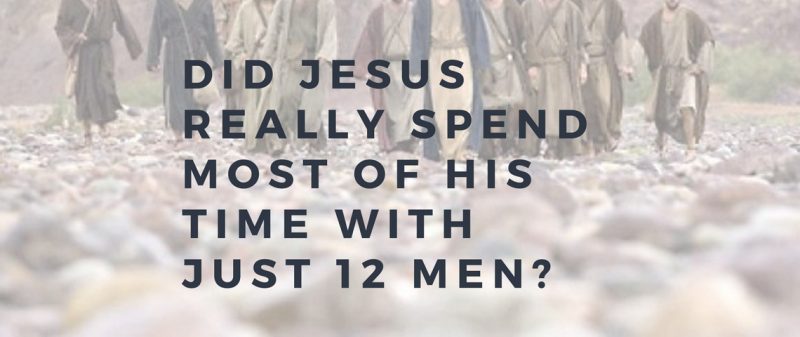An argument often used to restrict women from church leadership is that Jesus spent most of his time on earth investing in a group of 12 men. [1] But a close reading of the gospels shows that his band of followers also included women disciples.
I’ll leave the reader to their own survey of the gospels but offer these observations from my personal study. To keep this short I’ll stick mostly to references from Luke and John, but support can also be found in Mark and Matthew.
Jesus traveled with a group that included both men and women disciples.
In Luke 6 Jesus appoints twelve from among “a great company of disciples” to be apostles. Luke 7 records Jesus traveling with his disciples and this great crowd. Then shortly after beginning his public ministry, we read that as Jesus traveled “the Twelve were with him, along with certain women… and many others” (Luke 8:1-3). Luke lists Mary Magdalene, Joanna, Susanna, and “many others” as being in this band of disciples who traveled with Jesus. [2]
Another place we see evidence that women were among the disciples comes from Matthew 12:46-50: “While Jesus was still talking to the crowd, his mother and brothers stood outside, wanting to speak to him. Someone told him, “Your mother and brothers are standing outside, wanting to speak to you.” He replied to him, “Who is my mother, and who are my brothers?” Pointing to his disciples, he said, ‘Here are my mother and my brothers. For whoever does the will of my Father in heaven is my brother and sister and mother’.” There had to be women disciples in the crowd for him to point to, it seems.
The women disciples were not just supporting cast members.
When the Twelve are called we read that “they left everything and followed Jesus” (Luke 5:11). This concept of “following” is often used to describe discipleship in the gospels, and we find it also applied to the women in Luke 23:49: “But all his acquaintances, including the women who had followed him from Galilee, stood at a distance, watching these things.” And from Luke 8:3 we know that they provided financial support.
Many of these women followed Jesus from the start of his ministry all the way to the cross.
In their accounts of Jesus’ last days, all four gospel writers mention “the women who had followed Jesus from Galilee” (see Matthew 27:55, Mark 15:40, Luke 23:49, John 19:25). Taken together we find that eight women are named [2], with the most familiar being Mary Magdalene.
In Luke 24 some of these women are addressed by the two men at the tomb: “Remember what he told you while he was still in Galilee?” And we are told, “Then they remembered his words”. This confirms the longevity of their journey with Jesus and reminds us that they just didn’t show up in Jerusalem at the last minute. They’ve been present all along.
In addition, after his resurrection Jesus chose to reveal himself first to his women disciples. These women are probably the women mentioned as praying alongside the men in Acts 1 and present at Pentecost (Acts 2).
There is a reason most people cannot recall the names of all twelve of the apostles. Several are only mentioned by name only once or twice, if at all. But the stories of several women disciples are recorded in detail. The stories of some women disciples are more central in the gospel narratives than many of the Twelve.
Mary and Martha of Bethany
There are at least five references to Jesus being in Bethany, and most scholars assume that he stayed in the home of Mary, Martha, and Lazarus when he was there. Luke tells us that “Mary sat at the Lord’s feet” (Luke 10); an expression used to denote the disciple of a Jewish rabbi. John records Martha’s breathtaking confession of faith: “I believe that you are the Messiah, the Son of God, the one coming into the world” (John 11:27), comparable to that of Peter in Matthew 16.
We have the account of Mary’s anointing of Jesus with expensive perfume in John 12; which he interpreted as preparation for his burial. So I don’t think it is a coincidence that Jesus is in Bethany when he sends for a colt to ride into Jerusalem or that he spends his last few nights on earth in Bethany (Matthew 21:17, Mark 11:11-12). Or that it is to Bethany that he returns before his Ascension (Luke 24:50-51). Jesus loved Martha and her sister and Lazarus (John 11:5). They were among his closest friends and disciples.
The other Marys and Mrs. Zebedee
Mary Magdalene also features prominently in the gospels (mentioned about 12 times), as does Mary, the mother of Jesus. Both of these women traveled with Jesus from the beginning of his ministry to the cross [3] and historians note their importance in the establishment of the early church. Other women disciples named Mary are also identified, including Mary the mother of James and Joses and Mary of Clopas.
In Matthew 20:20 we read about the mother of the sons of Zebedee who asks Jesus to show favor to her sons. Just before this account Jesus and the disciples are noted to be traveling from Galilee to Jerusalem, suggesting that Mrs. Zebedee was a part of this group. This is confirmed in Matthew 27:55-56 which places her at the foot of the cross. While we fault her for selfishness, the record shows that she understood who Jesus really was – and such understanding was rare.
You can count on one hand the number of times the gospels depict Jesus alone with the twelve apostles.
The gospels writers only record a handful of times where Jesus takes the Twelve aside for teaching. There is the sending out of the Twelve and the Transfiguration (Luke 9), the prediction of his death and resurrection (Luke 18:31), the Last Supper (Luke 22), and the Ascension (Luke 24). [4]
Most often Jesus’ teaching is addressed to audiences that include both men and women. We read of the disciples being among the crowds (Luke 12), of large crowds traveling with Jesus (Luke 14:25), and of public teaching to audiences that include tax collectors, sinners, Pharisees, and legal experts (Luke 15-21). Jesus and the Twelve were not traveling by themselves around Galilee. Times in private were likely the exception more than the rule.
Time to Set the Record Straight
To say that Jesus spent most of his time investing in twelve men perpetuates the misconception that he traveled in the company of only male disciples and that women were excluded from his inner circle.
Such an interpretation sends a subtle message to men that they are more valued than women. And it sends a not-so-subtle message to women that they are not as worthy of being invested in as men. This does not do justice to the stories of discipleship of women in the Bible or to the inclusive message of the gospel.
Footnotes
[1] It should be noted that the twelve apostles were also all Jewish and chosen as representatives of the tribes of Israel, but that’s peripheral to this conversation. Read more: The Twelve Disciples Were All Male
[2] Matthew names Mary Magdalene, Mary the mother of James and Joses, and the mother of the Sons of Zebedee (27:55-56). Mark also names Mary Magdalene and Mary the mother of James and Joses and adds Salome (15:40-44). Luke identifies Mary Magdalene, Joanna, and Mary, the mother of James (24:10). John expands the list to include the mother of Jesus, his mother’s sister, and Mary of Clopas. Some scholars believe there may be some overlap in the lists, but even taking that into account, 6-8 women are named as having traveled with Jesus.
[3] Scripture References to Mary Magdalene: Matthew 27:56, 61; 28:1; Mark 15:40, 47; 16:1-19;Luke 8:2; 24:10; John 19:25; 20:1-18.
For further reading on this topic:
Male Female Equality in the Gospel of Luke
Were the Disciples Unschooled, Ordinary Men?





25 responses to “Did Jesus Spend Most of His Time with Just 12 Men?”
Thanks, your article is really great and interesting.
Excellent essay. Thank you.
I do have questions about this: “…and the Ascension (Luke 24). (4) ”
1. You suggest that only the 11 remaining chosen men were at the Ascension in Bethany. However, Luke 24:33 states that the two Emmaus disciples returned to Jerusalem and “found the Eleven and those with them, assembled together,”. The narrative then tells of Jesus coming among them, teaching them, and leading them to the vicinity of Bethany, to his Ascension. I see no indication that only the Eleven went there. How do you come to that conclusion?
2. You have a footnote number [4] at this point but I found no such footnote at the end of the article?
Thank you.
I’ve been thinking a lot about all of the Marys. I always do and especially on Good Friday, Holy Saturday and Resurrection Day.
So many times I’ve heard male pastors say the Marys and other women could have remained at the cross and slipped out early Sunday morning to go to Jesus’ tomb, because they were not men and therefore were not in danger from the Romans.
I hardly think the Romans would have been squeamish about harassing women!
What if the women disciples simply loved so much and and no regard for their own safety? What if they simply TOOK courage. What if they stayed through it all –all the bleeding, the torture and the dying without thinking of fear or courage. What if they arranged all the spices all day Saturday and left on Sunday because they wanted to care for Jesus’ body. They were THERE! That’s why they were the first to know Jesus had been raised to life.
Mark says the women were terrified after they saw the angels and heard that Jesus had risen. But no Gospel says they were terrified before then.
I’m reminded of the Pharaoh’s fear of males and his orders to destroy them, and yet it was females all the way that thwarted his designs, even his own daughter! Midwives, Mothers, Sisters, Daughters. And now, with Jesus, the daughters of Jerusalem, who love much, witness the resurrection and are sent out to tell the other disciples.
Wow, Karen…fantastic points there! Thanks for sharing them with us.
The Romans did indeed crucify women, and even children. When putting down a revolt, they not only crucified the leaders, but everyone they suspected of being followers. There was a large uprising after the death of Herod the Great, and the Romans crucified about 2000 people. No wonder Jesus’ male disciples fled. They were afraid of being crucified also.
But it is a greater credit to the women’s devotion that they stayed and faced possible execution. Part of the humiliation of crucifixion was that the criminal was stripped naked and molested.
“According to Roman law, if a slave killed his or her master, all of the master’s slaves would be crucified as punishment.[88] Both men and women were crucified.[89][90][87] Tacitus writes in his Annals that when Lucius Pedanius Secondus was murdered by a slave, some in the Senate tried to prevent the mass crucifixion of four hundred of his slaves[88] because there were so many women and children, but in the end tradition prevailed and they were all executed.[91] Although not conclusive evidence for female crucifixion by itself, the most ancient image of a Roman crucifixion may depict a crucified woman, whether real or imaginary.[a] Crucifixion was such a gruesome and humiliating way to die that the subject was somewhat of a taboo in Roman culture, and few crucifixions were specifically documented. One of the only specific female crucifixions we have documented is that of Ida, a freedwoman (former slave) who was crucified by order of Tiberius.[92][93]”
I’m delighted to hear you refer to Mary of Bethany anointing the feet of Jesus with pure nard in John 12. Perhaps the pound of perfume she used was left from the burial of her brother, Lazarus. Her act of foot washing after Jesus resurrected her brother, no doubt was done in loving gratitude. Now she used it to prepare Jesus for His burial. Not surprising that Mary of Bethany was criticized by the Disciples for having spent too much money 🙂 They did not seem to understand.
Yet in the next chapter of John, we see Jesus wash the feet of his Disciples and insist the importance of this to Peter! Yes, it is time to lift up the New Testament women who followed Jesus and believed in Him. Their witness is there!
Gail,
When people attempt to drive a wedge between the sexes in the Gospel, I consider what Jesus said about the woman married to 7 brothers. God simply doesn’t distinguish us by x and y chromosomes. He doesn’t call men to repentance; He calls US. He didn’t minister to one sex and not the others; he fed and ministered to all around Him; men, women, and children.
Thank you for this article!
I’d love to have you check out my latest blog for Easter when you get a chance. It’s at http://SelahMusings.com. Just click on the SelahMusings Blog menu item to get to the latest postings. Titled: Into The Likeness of Christ.
Direct link is: http://selahmusings.com/…/03/27/into-the-likeness-of-christ/ .
Blessings,
Kip
Yes, there is so much insight into this post. Thanks Gail
Thanks, Bev!
The 12 male apostles were chosen to represent the patriarchs of the 12 tribes of Israel while Jesus was still working in his temporal mission under the Old Law.
After the redemption, and the resurrection, under the New Law, the church is in charge of mediating all vocations, including vocations to ordained ministry.
Now that the patriarchal culture of male headship is passing away, we need women pastors, women priests, women bishops, and a woman pope. What is the feminine for “pope”?
I like BT Roberts’ observation back in the late 1800’s that the 12 were also all Jewish – does this mean all leaders must be Jewish?
This is incredibly helpful and informative. As we’ve been singing Passion week songs about how we too abandoned and denied Jesus just like his disciples, I keep thinking, “Actually, this is NOT how his female followers reacted! They stayed with him from beginning to end and were first to witness the resurrection.” There’s absolutely no reason to discount their discipleship and faithfulness or ignore the favor Christ granted them as first witnesses and proclaimers of the resurrection.
Yes. It is amazing how we can read and preach the text from a patriarchal perspective and miss the obvious. A great example of hyperfocus.
Hi, Denny! I’m amazed that I didn’t catch that import of Luke 8:1-3 until just a few years ago. Crazy!
Yes, I agree with all of that, Bailey! The narrative needs to be corrected.
If I may add, there were 120 disciples in the upper room at Pentecost. Didn’t it day that they returned to the upper room? Wouldn’t that make 120 men and women at the Last Supper? Not just twelve men?
Yes, that is another story that needs to be explored! Hoping to research it and write a post some day. Having been to Jerusalem several times it’s hard to imagine a meeting space that large, but it’s an interesting theory.
Thank you. Too many men today, and some women, seem to genuinely believe that Jesus lived according to the dictates of the Pence Rule. I am baffled as to how they think Jesus or anyone pastor/minister claiming to work for Him could do the job by providing full ministry to men and half a ministry (or less) to women. When we exclude women from ministry and claim beliefs like the Pence Rule, women are openly left behind in terms of ministry they need. Jesus did not do this.
Amen to that! Well said.
Good insights, Gail. Do you think Cleopas in Luke 24 and Clopas in reference to Mary might be connected? Could Mary have been the second disciple Jesus spoke to on the road to Emmaus?
Hi, Tim. I have heard that before and in some ways it makes sense, especially since it says they had Jesus in their home. But I have to wonder why the author didn’t just name her if that was the case since other women are named. But I like to think it was her on the road!
Thank you thank you thank you! Easter goodness in here.
You are very welcome! Grace and peace to you this Easter.